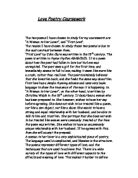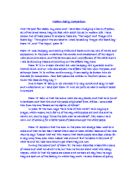Pre-war poetry coursework:
Each of the poems in comparison, both ‘Ode to a Nightingale’ (John Keats) and ‘To the Skylark’ (Percy Bysshe Shelley), are using birds to reveal the deep emotion and pain that each poet has locked away within themselves. The complex build of each poem uses a structure of such clever techniques as metaphors, similes, sibilance, oxymoron and alliteration. Bereavement, longing for love and empathy all forcefully shown within descriptions of two birds a Skylark and a Nightingale.
‘Ode to a Nightingale’ is John Keats’ observation of human life; he battles with the mixture of pain and joy, greatness of feeling life and the darkness of feeling death, mortality and immortality, the realistic and idealistic world surrounding, and of parting as well as correlation.
Stanza 1 begins with John Keats falling into a daydream whilst listening to an actual nightingale sing. His response to the beauty of the song is that of joy, yet also pain! Feeling as though he had drank ‘hemlock’ showed the pain he was feeling, as this is a poisonous drink made from a herb, he uses this in a powerful simile that shows to the exact extent of his sorrow. He continues his feeling of unhappiness by saying ‘One minute past, and Lethe-wards had sunk’ - Lethe being the a river in Hades (the Greek underworld); souls about to be reincarnated drank from it to forget their past lives. It’s as though he is trying to reveal to the reader that he wishes to forget the past as it has caused him so much pain! Stanza 2 goes straight into the fact that he wishes to escape – escape the pain that this reality of life is, escape the fact that death must come and pain it causes. His exit via wine, not to get drunk but he sees it as his entrance to the mental state he desires so that he can write and imagine as he wishes to and using it as an inspiration. The poem shows how he seeks to be like the bird - qualities of the wine would help him to gain such properties; he later mentions in the play how he believes the bird is immortal, ‘thou wast not born for death, immortal bird’ this is as though he believes the bird shall not die, did he feel the wine would too give him that ‘indestructible’ property. The bird is happiness and with that there is associated summer and song. He is embedded with jealousy for this bird that he sees is singing a joyful song, he longs for that happiness and tranquillity! Stanzas 3 and 4 are very focused in on death, he wishes he could eliminate it taking with it the pain he curses, this is shown through his alliteration in ‘away, away’. His poem is very biographical, telling his whole life of sorrow and wishes and sharing his pain in the first person. He embarks personification by saying ‘Mid-May’s eldest child’ When Keats turns to death and says ‘ I have been half in love with easeful Death’ we question if he is being suicidal and the capital letter on death explains that he sees death as more of a character, possibly a person taking all these people from around him. Towards the end it is revealed in true depth the sadness that lay inside Keats. The whole poem questions the meaning of life and why we have to suffer such pains as bereavement and whether nature such as birds feel this; Keats has demonstrated how the beauty of the nightingale really made him envious and his techniques really showed his sorrow! The rhyme scheme is ABABAB.







